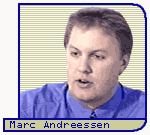 |
|||
 |
|||
![]() A Human Face
A Human Face
The University of Illinois at Urbana-Champain had always been on the forefront of computer science. It was one of the first dozen nodes on the ARPAnet, and it was chosen to manage the National Center for Supercomputer Applications (NCSA). Much of the world's high-power computing happens at UIUC, but not necessarily on campus.
One of the strategies of the NCSA was to provide access to the supercomputers for the country's and world's researchers. Around the clock, scientists would submit jobs to the Cray supercomputers over the NSFnet (the successor to the ARPAnet) and download the output. An army of staff and students maintained the campus computers to keep the connection stable and open.
 In 1992, a few of the students led by
Marc Andreessen
came across the World Wide Web protocol released from CERN. They thought
it was a great idea, but it was clumsy for most people with a minimum
of skill with the computer. They decided it would be a fun a potentially
worthwhile project to write a friendlier, graphical interface on the
browser. When they had one finished, people asked them to write one
for their PC or the Macintosh. Eventually they released it on the Internet,
and the downloads increased steadily. In 1993, Andreessen's
Mosaic
browser was used by over one million people around the world. He had
a hit, but he didn't realize it, and it was the school's property.
In 1992, a few of the students led by
Marc Andreessen
came across the World Wide Web protocol released from CERN. They thought
it was a great idea, but it was clumsy for most people with a minimum
of skill with the computer. They decided it would be a fun a potentially
worthwhile project to write a friendlier, graphical interface on the
browser. When they had one finished, people asked them to write one
for their PC or the Macintosh. Eventually they released it on the Internet,
and the downloads increased steadily. In 1993, Andreessen's
Mosaic
browser was used by over one million people around the world. He had
a hit, but he didn't realize it, and it was the school's property.
After graduation, Andreessen found a job in Silicon Valley and moved away from Illinois. High-tech firms were on shaky ground as the computer business was uncertain about their future. Jim Clark, the founder of SGI, decided to retire and look for something new to work on. Clark found out the Andreessen was working nearby, so he arranged a meeting to talk about Mosaic.
Clark was impressed with Andreessen and his enthusiasm for the browser. He decided to invest in a new software company, but he wanted Andreessen to recruit everyone that was involved in writing the Mosaic browser at the University of Illinois. Both of them flew back to Illinois and offered six of the original seven a job in the new company - the seventh, Chris Wilson, had already been hired at Microsoft.
 Jim Clark, who had
started SGI directly from Stanford,
assumed that the University of Illinois would act the same way as Stanford
and be pleased to permit a commercial spin-off with a student-created
product. Afterall, grateful graduates were generous donors. However,
UIUC didn't see it that way and refused to relinquish the Mosaic name.
Jim Clark, who had
started SGI directly from Stanford,
assumed that the University of Illinois would act the same way as Stanford
and be pleased to permit a commercial spin-off with a student-created
product. Afterall, grateful graduates were generous donors. However,
UIUC didn't see it that way and refused to relinquish the Mosaic name.
Andreessen and the Gang of Six eventually rewrote the browser and changed its name to Netscape Navigator (actually, they have always called it Mozilla). Clark used a unique marketing plan, one born for the Internet. Anyone could download it, but if they used it for their own business they had to pay for a license.
"In about a year and a half's time, we had 65 million users - the most rapidly assimilated product in history. No one had ever achieve an installed base of 65 million anything, except perhaps Microsoft."
Netscape
Copyright © 1998, PBS Online,
Inc. All Rights Reserved.
Site Designed and Developed by OPB Learning
Media